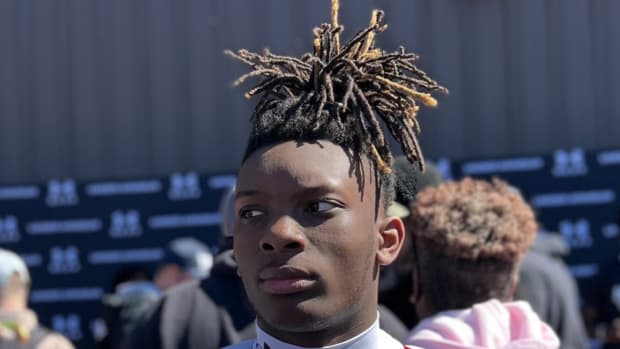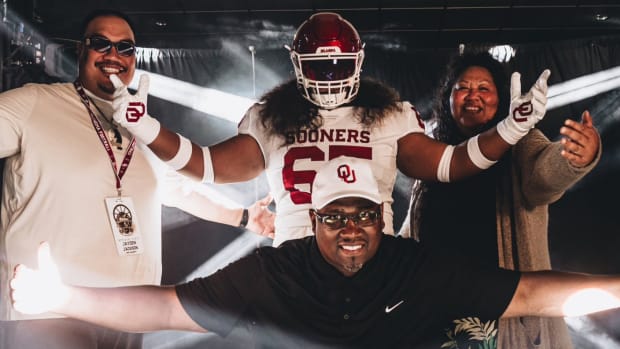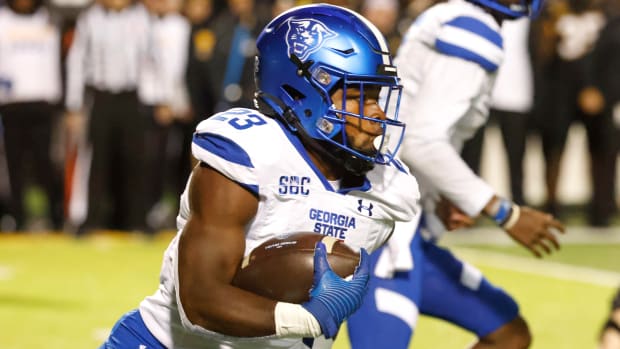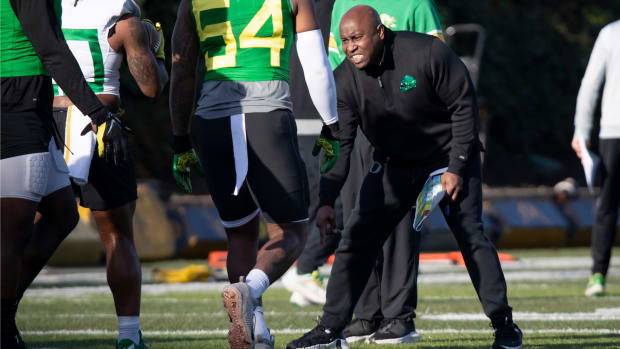After an Uncharacteristic 2018, Wisconsin's Staunch Defense Is Back
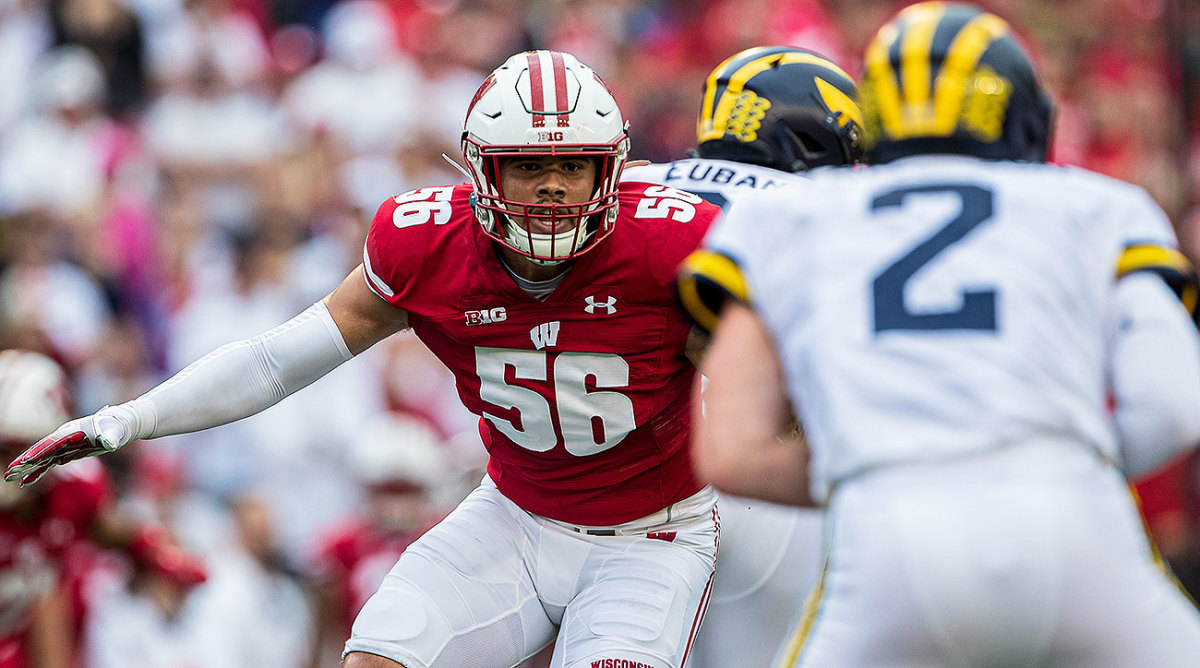
The best defensive drive of Wisconsin’s season began with a missed tackle.
You have reached your limit of 4 premium articles
Register your email to get 1 more
The Badgers hadn’t had many mistakes in two shutout games before last Saturday’s matchup against then-No. 11 Michigan, but on the Wolverines’ first offensive play of the game, safety Eric Burrell missed his man. Michigan receiver Ronnie Bell was off to the races, and he appeared poised to tie the game at a touchdown apiece—before Faion Hicks, a sophomore cornerback, caught him at the Wisconsin 7-yard line. On first-and-goal, Shea Patterson tossed an incompletion, and next, the Wolverines quarterback handed the ball off to fullback Ben Mason, hoping to muscle in the score.
Instead, Wisconsin safety Reggie Pearson forced a fumble at the 4-yard line. Burrell, he of the missed tackle, pounced on the ball. The Badgers kept Michigan off the board, and it wouldn’t get its first points for another two quarters.
“Everyone can take a deep breath on the sideline and feel comfortable,” defensive coordinator Jim Leonhard says of that stop, which he calls the best of his unit’s season. “If they punch that in, even if they get a field goal, who knows? The momentum of that game could be completely different. [That style of play is] exactly what you preach to your players week in and week out: the effort, the intensity that you play with, it matters.”
Leonhard pauses. “And,” he continues, “it comes out of a bad play.”
With the fumble recovery, Wisconsin, now ranked No. 8 in the AP Poll, sparked a series of stops that included four punts and an interception. The Badgers took a 28–0 lead into halftime and would go on to win the game, 35–14, allowing Michigan 299 yards of total offense, a paltry 40 of which came on the ground. The Wolverines didn’t convert a single time on 11 third-down attempts, marking just the eighth time in five years that a ranked team has been stopped on each of its third-down conversions, per STATS. And in stretching their shutout to the season’s first 10 quarters, the Badgers became the only team since STATS began keeping such records in 1996 to not allow a point for the season’s first 10 quarters. (They’re one of four teams in that time frame, according to STATS, to shut out their first two opponents. The last time a team did so? Wisconsin in 2013.)
“That's what this defense is made for, and it speaks volumes [about] the guys we have, not giving up and just being a gritty defense,” outside linebacker Zack Baun says of the stop that defined the game. “It's never over ‘til it's over in the end zone. It's not just that one guy misses a tackle. It's 'I got your back. I'll run down 65 yards and make this tackle for you.’”
Wisconsin’s defensive efforts so far look a lot like what the team did in 2016 (under coordinator Justin Wilcox) and ’17 (under Leonhard). In ’16, Wisconsin finished with the No. 7 defense in FBS, allowing opponents an average of 301.4 yards, and it was especially stingy against the run, where it ranked third overall, allowing 98.8 yards on average. The next season, with Leonhard in charge, it got even better: an average of 262.1 total yards (second in the FBS to Alabama, and barely) and 98.4 rushing yards allowed, and opponents completed just 48.6% of their passes against the Badgers’ strong front and speedy secondary, an FBS-best among defenses.
Then 2018 happened. After three years of coordinator turnover (Dave Aranda left after the 2015 season, Wilcox after ’16), the team finally achieved continuity with Leonhard. The program had recruited well, and it brought back several stalwarts from the previous year, including linebackers T.J. Edwards, Andrew Van Ginkel and Ryan Connelly and cornerback D’Cota Dixon. Preseason expectations were high—and seemingly ignored the fact that Wisconsin had lost four defensive starters to the NFL draft: cornerback Nick Nelson, safety Natrell Jamerson and linebackers Jack Cichy and Leon Jacobs. These weren’t big-name, first-round picks, but they were a large part of the core of the Badgers defense. Their absence showed. Last fall, Wisconsin regressed to something like average, allowing opponents 344.2 yards per game—a whopping (for the Badgers, at least) 155.1 of which came on the ground. A young and injured secondary contributed to the team falling from first to No. 55 in opposing quarterback completion percentage, which rose to 57.9% on the year.
"We'll never repeat that for as long as I'm here and for as long as the Wisconsin football program is standing,” Chris Orr, a fifth-year senior linebacker, says. “That was kind of the message that I put out there [after last year]: We need to be nasty, no miscues, no blown assignments. If you can do that as a defense, we will be pretty good. So that was the message that I preached: everybody running for the ball, everybody being on top of their assignment and being physical. We want to dominate physically.”
So far this year, that’s been the case. Through three games, the Badgers are allowing opponents an average of 177 yards; the next-best team, Ohio State, averages 222.5. What’s been most impressive, though, has been the rebuilt front seven, which has allowed opponents 98 rushing yards in three games—total.
Yes, these numbers have come against South Florida, Central Michigan and a disappointing Michigan squad. They’re bound to trend upward as the Badgers make their way into Big Ten play—but there’s no reason to expect they’ll spike, or that Wisconsin will cede its place at the top of the FBS. Last fall is looking more and more like an aberration rather than the start of a disturbing trend, and for that, the team largely credits the experience its young players gained a season ago.
"Last year, a lot of guys—a lot of young guys, including myself—had never been on the field that much,” Baun says. “We were just trying to get on the field and get reps and focusing on not messing up, and at times playing timid. But [this year]... guys aren't only just trying to get on the field, they're trying to make a play and they're trying to play well. They're trying to prepare so that they can go out there and just let it loose."
It might be as simple as that: experience. Leonhard quibbles with that characterization, though. “Guys that gained experience, it means nothing if you can’t turn it into confidence,” the coordinator says. Last season’s bowl game against Miami sowed the seeds for that; in the game, Wisconsin looked like its old self, allowing the Hurricanes 169 yards and pulling in five turnovers. “I don’t care if you’ve played one snap of football or a million,” Leonhard continues, “the guys that can turn that experience and their knowledge and understanding of football into confidence and play with a level of confidence—that's the magic.”
Leonhard also says that in year three on the job, he’s learned to trust his gut. After 2017, he had several ideas for how the defense could evolve and move on from the players it lost. But on paper, there were solutions at each position, young guys with a ton of talent. And so, Leonhard says, he thought to himself, let’s not mess it up. He went into the season with nearly the same approach as the year before, with a group of players who needed a change. “You really look back at the end of the year, and that gut instinct was right, and I think we could’ve helped that group of guys out a little bit more than we did,” Leonhard says.
Orr says this season, Leonhard’s scheme has been more aggressive going after opposing quarterbacks. Players have earned more freedom, and Leonhard has learned how to tailor his system to their strengths. “It's not just a system that you can plug a whole bunch of different guys into; it's very custom and very intricate,” Baun says. “[Leonhard] knows us personally, individually, and he knows how to how to use us together."
It helps, too, that the Badgers have had consistency on offense after anything but in 2018. New quarterback Jack Coan has yet to throw an interception, and the team has lost only two fumbles through three games. There’s a rhythm, and with Jonathan Taylor chewing up yards on the ground, Wisconsin can drain the clock and back opposing offenses up against a wall. They need to score, and they need to score fast, forcing them to all but abandon the run—and allowing the Badgers’ dangerous front seven to focus almost exclusively on hunting the quarterback.
For the next month, the Badgers will have plenty of opportunities to pad their stats, to advance Taylor’s case for the Heisman and cement themselves at the top of the defensive rankings in nearly every category. On Oct. 26, their next major test arrives in the form of a game at Ohio State. They get a bye between that and Iowa’s trip to Camp Randall, and after that, they should coast to the end of the season and, they hope, a return to the Big Ten championship game after a season away. Like that first drive against Michigan, this year’s Wisconsin team is the product of a mistake, of a season that looked a lot like mediocre—and it’s better for it.


